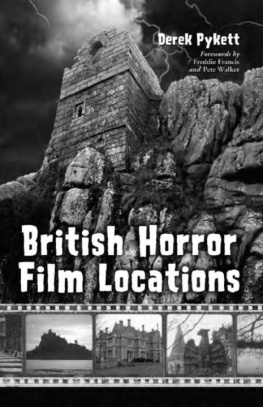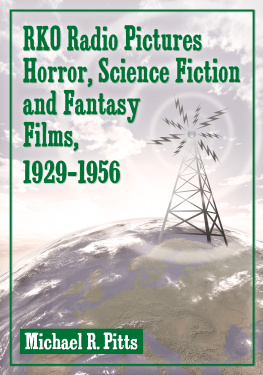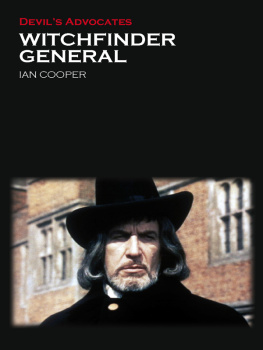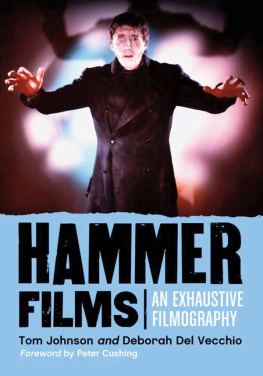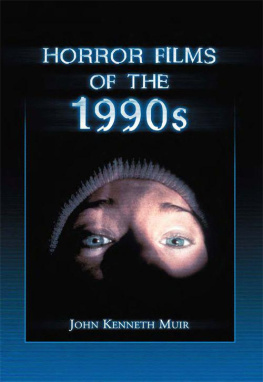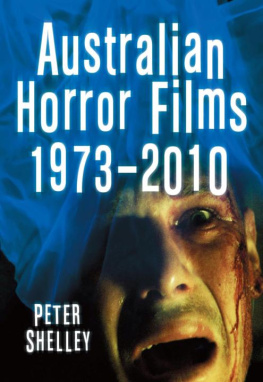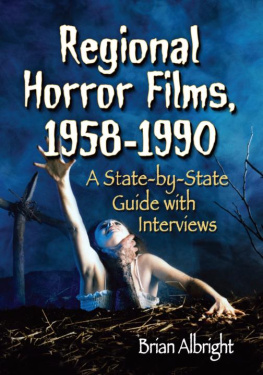




This book is in loving memory of my mother, whom I miss more and more with each passing day; dedicated to my late friend, Freddie Francis (1917-2007), a first-class gentleman, cinematographer, and unique horror film director; and for Ruth Potter, the love of my life.
Many people have contributed to the production of this book by providing me with help, support, suggestions and invaluable information. They have made this long-overdue reference book possible. They are:
My Dad and my whole family, to whom I shall always be eternally grateful. Without their continuous support, nothing I have done would have been possible.
Luke Pykett, my younger brother, for helping me with my research throughout the writing of this book.
Ruth Potter, my beautiful fiancee, for helping me to hunt out locations in Hertfordshire, and for taking numerous photographs.
Pete Walker and the late Freddie Francis, for taking time out and being kind enough to write the forewords.
Simon Flynn, for writing additional material for this book, and supplying me with over 50 percent of the photographs. To him I am indebted, and enormously grateful.
Colin Beardmore, for finding me addresses and phone numbers of important film personnel, many of whom have helped me during my research. To him I send my deepest thanks.
Terry Pearce, who came forward with some amazing location material, which has enhanced this book 100 percent.
Cecelia Doidge-Ripper, a special friend who, with late husband Michael Ripper, inspired me to write more filmic material.
Brian Holland, a very dear friend, and his wonderful family, who always supply me with endless kindness, support, help and encouragement.
Andrew Thirlwall Potts, my thespian colleague and friend, who is always at hand to help me with research.
Pamela Francis, for helping me to track down some of the locations within this book's pages.
Sally-Anne Ryan, a special and dear friend who has helped me on several occasions during my research - and never fails to make me laugh.
Sandy Collis and Nick Wright, close friends who are always there when I need someone, both in a private and professional way.
Theresa Doyle, Michael and Karmellah Howlett, Danny R. Fulce, Ian Tyler, Martin Killeen and Elmar Podlasly - who have always been true friends to me, and have made my life a brighter place for it.
Peter Sasdy, Geoffrey Bayldon, Christopher Lee, Sue Atkinson, Norman J. Warren, Kristi Blicharski, Susan Van Den Broek, Richard Fleischer, David Wickes, Melvin Sullivan, Piers Haggard, Jim Clark, Paola Bonelli, Mimsy Farmer, Quentin Falk, Gloria Barclay, Sharon Henson, Darren Perry, Richard Norton, Isobel Blackley, Joe Miller, Denis All, Frances Russell, John Harris, Paul Arnett, Ronnie Maasz, Keith Topping, Norman Eshley, Bernard Ford, John Hough, Lord Attenborough, Jimmy Sangster, David McGillivray, Peter Jessop, Peter Sinclair, Peter Duffell, Linda Hayden, Val Guest, Tony Reeves, Jean B. Pateman (Highgate Cemetery), Paul Follows (Grim's Dyke Hotel), Jon Beecroft (Oakley Court Hotel), Lee Montague, Neil Binney, Kevin Francis, Sharon Astley (Brocket Hall), Ingo Wiangke (Ettington Park Hotel), Gordon Kingsley (Harlaxton Manor), Roy Ward Baker, Tony Spratling, lain Wakeford, Jim O'Sullivan (Orford Castle), Andy Jones, Donald Fearney, James Keeble, Beryl Earl, Alan Birkinshaw, Vic Smith, Lord Aldenham, Michael Grant, Dennis Payne, Ann Runeckles, Anthony Waye, Wayne Kinsey, Bushey Library (Hertfordshire), Wilton's Music Hall (London), Matthew Bryant, Simon Sprackling, Ken Baker, Nick Daubeny, Malcolm Middleton, Brian Daubney, Diane Halfpenny (National Trust/Ashridge Estate), Robert Bard - to all of the above, a big thank you, and I shall always be forever grateful.
Illustrations Courtesy of: Simon Flynn, Ruth Potter, Terry Pearce, SallyAnne Ryan, Freddie Francis, Ettington Park Hotel, Elmar Podlasly, Orford Castle, Wayne Kinsey, Wykehurst Place, Alan Hughes, Brian Holland and Kate Holland.
vii
Very rarely on any of the horror movies I directed did we have the budget to film on location. When we did get the chance, I always enjoyed it much more than being confined within a studio space. Also, being a cinematographer, it is much more interesting to the eye to film at a real location.
So, having used a few of the locations revealed in this book, I am delighted that Derek Pykett has researched and listed them so well.
I have no doubt they will be of interest to many fans who will be able to identify them (or not!), together with the many grisly events that might, or might not, have taken place there.
Isleworth, London
Films listed: Craze (1974), The Creeping Flesh (1972), Dr. Terror's House of Horrors (1965), Dracula Has Risen from the Grave (1968), The Elephant Man (1980), The Ghoul (1974), The Innocents (1961), Legend of the Werewolf (1974), Son of Dracula (1974), Tales from the Crypt (1972), Trog (1970)
When I first started taking an interest in movies, probably at eleven or twelve years of age, one of the first things I learned was the enormous cost of film making which has always been hard to come to terms with. Even in the 1930s, for example, the AstaireRogers films apparently nearly broke RKO Radio Pictures mainly because of the cost of the sets. It is said that the black marble ballroom set for The Gay Divorcee cost one million dollars in 1934, the era of deco super-dance halls which existed in many towns in the USA.
"Why could they not have made it on location?" I said to my production manager when he showed me around the studio ballroom set of the film he was working on, The Ruling Class, in 1972. "We're paying 6,000 a day for the hire of that chandelier," he said, pointing to an enormous glass contraption hoisted up into the gantry. "It's been there for three weeks already and we haven't started shooting on this set yet." Every production crew will have stories of mind-boggling waste and excesses of course. Even as a teenage bit player in black-and-white "B" movies around the early '60s, I was amazed that these Poverty Row movies would be constructing ordinary living rooms or kitchens - sparsely furnished and with very little atmosphere - in studios, when the entire film could well have been shot on location, with the money saved spent on a better cast to enhance the salability of the product.

